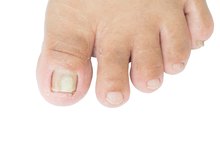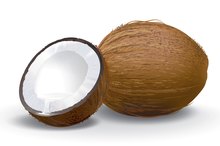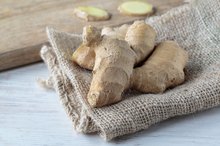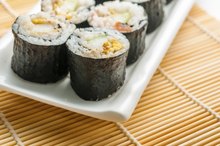Coconut Oil for Athlete's Foot
Coconuts are versatile fruits with a wealth of practical, culinary and medicinal benefits. Coconut oil, a saturated fat, boosts immune function and protects against a variety of pathogens. Eighty percent of the medium-chain fatty acids in coconut oil are antimicrobial against bacteria, viruses, fungi and protozoa, according to health editor Cynthia Holzapfel, author of the book "Coconut Oil: For Health and Beauty. 6"
Medium-Chain Fatty Acids
Medium-chain fatty acids found abundantly in coconut oil provide considerable antifungal effects, according to naturopath Bruce Fife, author of the book "The Coconut Oil Miracle." Caprylic acid has been used successfully in combination with certain antifungal herbs as an alternative to conventional antifungal drugs in the treatment of yeast infections and recurrent skin infections such as athlete's foot and ringworm 2. Caprylic acid can be combined with coconut oil or vitamin E and applied to affected areas. This coconut oil derivative has a high safety profile. Caprylic acid can be taken internally as a supplement to control intestinal yeast overgrowth, a condition that may make you more susceptible to other fungal infections, such as athlete's foot.
- Medium-chain fatty acids found abundantly in coconut oil provide considerable antifungal effects, according to naturopath Bruce Fife, author of the book "The Coconut Oil Miracle."
- Caprylic acid can be taken internally as a supplement to control intestinal yeast overgrowth, a condition that may make you more susceptible to other fungal infections, such as athlete's foot.
Broad Spectrum Antifungal
How to Heal Dry Cracked Hands With Vinegar
Learn More
A variety of Candida species responded well to treatment with coconut oil in a study published in the June 2007 issue of the "Journal of Medicinal Food." Researchers concluded that coconut oil shows promise as a treatment for drug-resistant fungal infections 1. In the study, coconut oil compared favorably to the antifungal drug fluconazole against some fungal species.
Lauric and Capric Acids
Lauric acid and capric acid, two other medium-chain fatty acids in coconut oil, are also effective at controlling fungal infections. Lauric acid works by disrupting the fungal cell membrane, resulting in a disorganized and shriveled cell, according to nutritionist Cheri Chalbom, author of the book "The Coconut Diet: The Secret Ingredient That Helps You Lose Weight While You Eat Your Favorite Foods." Chalbom notes that coconuts grow in warm tropical areas where fungi abound, yet fungal infections are rare in people in those places who eat coconuts and coconut oil as a staple in their diets 4.
Treatment Options
Vicks VapoRub & Toenail Fungus
Learn More
A combination of coconut oil with tea tree oil is helpful for controlling athlete's foot and other fungal rashes, according to Dr. Mary Enig, author of the book "Eat Fat, Lose Fat: Lose Weight and Feel Great with Three Delicious, Science-Based Coconut Diets." A foot bath with coconut vinegar and tea tree oil has been used with success against athlete's foot 3. Also, massage your feet before bed using coconut oil along with a few drops of lavender, rosemary, cyprus or tagetes essential oils, which have antiseptic properties.
Related Articles
References
- "Journal of Medicinal Food"; In Vitro Antimicrobial Properties of Coconut Oil on Candida Species in Ibadan, Nigeria; D. Ogbolu, et al.; June 2007
- "The Coconut Oil Miracle"; Bruce Fife; 2006
- "Eat Fat, Lose Fat: Lose Weight and Feel Great with Three Delicious, Science ..."; Mary G. Enig, et al.; 2004
- "The Coconut Diet: The Secret Ingredient That Helps You Lose Weight While You ... "; Cherie Calbom, et al.; 2005
- "Coconut: Rediscovered as Medicinal Food"; Harald Tietze; 2006
- "Coconut Oil: For Health and Beauty"; Cynthia Holzapfel, et al; 2004
- Patil, U, Benjakul, S. Coconut Milk and Coconut Oil: Their Manufacture Associated with Protein Functionality. J Food Sci. 2018;83. doi:10.1111/1750-3841.14223
- Coconut milk. U.S. Department of Agriculture FoodData Central. 4/1/2019
- Coconut meat, fresh. USDA FoodData Central. 4/1/2019
- Mcrorie JW, Mckeown NM. Understanding the Physics of Functional Fibers in the Gastrointestinal Tract: An Evidence-Based Approach to Resolving Enduring Misconceptions about Insoluble and Soluble Fiber. J Acad Nutr Diet. 2017;117(2):251-264. doi:10.1016/j.jand.2016.09.021
- Siri-tarino PW, Sun Q, Hu FB, Krauss RM. Saturated fat, carbohydrate, and cardiovascular disease. Am J Clin Nutr. 2010;91(3):502-9. doi:10.3945/ajcn.2008.26285
- Boateng L, Ansong R, Owusu WB, Steiner-Asiedu M. Coconut oil and palm oil's role in nutrition, health and national development: A review. Ghana Med J. 2016;50(3):189–196.
- Eyres L, Eyres MF, Chisholm A, Brown RC. Coconut oil consumption and cardiovascular risk factors in humans. Nutr Rev. 2016;74(4):267–280. doi:10.1093/nutrit/nuw002
- Chinwong S, Chinwong D, Mangklabruks A. Daily consumption of virgin coconut oil increases high-density lipoprotein cholesterol levels in healthy volunteers: a randomized crossover trial. Evid Based Complement Alternat Med. 2017;2017:7251562. doi:10.1155/2017/7251562
- Patil, U, Benjakul, S. Coconut Milk and Coconut Oil: Their Manufacture Associated with Protein Functionality. J Food Sci. 2018;83. doi:10.1111/1750-3841.14223
- Wang, Y, Liu, A, Han, Y, et al. Medium Chain Triglycerides enhances exercise endurance through the increased mitochondrial biogenesis and metabolism.PLoS ONE.2018;13(2):e0191182. doi:10.1371/journal.pone.0191182
- Mumme K, Stonehouse W. Effects of medium-chain triglycerides on weight loss and body composition: a meta-analysis of randomized controlled trials. J Acad Nutr Diet. 2015;115(2):249-63. doi:10.1016/j.jand.2014.10.022
- Prior, I,Davidson, F, Salmond, C, et al. Cholesterol, coconuts, and diet on Polynesian atolls: a natural experiment: the Pukapuka and Tokelau island studies. Am J Clin Nutr. 1981;34(8):1552-61. doi:10.1093/ajcn/34.8.1552
- Sankararaman S, Sferra TJ. Are we going nuts on coconut oil?. Curr Nutr Rep. 2018;7(3):107-115.doi: 10.1007/s13668-018-0230-5
- Li Y, Zheng Y, Zhang Y, Xu J, Gao G. Antioxidant activity of coconut (Cocos nucifera L.) protein fractions. Molecules. 2018;23(3):707. doi:10.3390/molecules23030707
- Antioxidants: In Depth. National Center for Complimentary and Integrative Health. Updated May 04, 2016
- Potential to react to coconut if one is allergic to other tree nuts. American Academy of Allergy, Asthma, and Immunology. Updated 4/25/19
- Anagnostou, K. Coconut Allergy Revisited. Children (Basel). 2017;4(10):85. doi:10.3390/children4100085.
- Sprouse AA, van Breemen RB. Pharmacokinetic Interactions between Drugs and Botanical Dietary Supplements. Drug Metab Dispos. 2016;44(2):162–171. doi:10.1124/dmd.115.066902
- Nuts, coconut meat, dried (desiccated), sweetened, shredded. USDA FoodData Central. Updated 4/1/2019
- Coconut milk. U.S. Department of Agriculture FoodData Central. 4/1/2019
- Coconut water. U.S. Department of Agriculture FoodData Central. 4/1/2019
- Coconut oil. U.S. Department of Agriculture FoodData Central. Updated 4/1/2019
Writer Bio
Tracey Roizman, DC is a writer and speaker on natural and preventive health care and a practicing chiropractor. She also holds a B.S. in nutritional biochemistry.









